Earth Island Journal takes an in-depth look at how and why congestion pricing got the kibosh in New York.
"On Earth Day 2007, Mayor Bloomberg put forth a 30-year redevelopment plan (PlaNYC) for the city that included congestion pricing as "part of an overall commitment to increase investment in mass transit." Although it was one of only 127 environmental initiatives, such as boosting street-side tree planting and protecting wetlands, congestion pricing received a disproportionate amount of attention, and led to a lively and often fractious debate among city and state lawmakers, local residents, and urban planners. A 17-member ad hoc committee was formed to hone the mayor's plan, and dozens of community meetings were held across the city to solicit residents' views. Bloomberg made the issue a top priority, and invested a large amount of his political capital in passing the measure. But the idea ran into stiff resistance. Opponents, particularly city council members and state assembly members who represent the outer boroughs, decried the legislation as a tax on the poor and middle class, one that would turn Manhattan into a golden ghetto. It was an effective populist appeal, an argument that everyone has the right to drive, and that right should not be infringed upon even if, in the case of NYC, the vast majority of commuters do not drive.
Ultimately, Bloomberg's plan, which narrowly made it through the city council, was scrapped by the state legislature in Albany. The NY state legislature often intervenes in city affairs, and reserves the right to oversee many local decisions – for example, the number and type of red light enforcement cameras, bus lane enforcement cameras, and speed limits for traffic calming designs. It is likely the city's authority to charge drivers would have been challenged in court, delaying the plan indefinitely. As it was, the assembly put the idea to rest."
FULL STORY: How NYC's Congestion Pricing Plan Crashed

Alabama: Trump Terminates Settlements for Black Communities Harmed By Raw Sewage
Trump deemed the landmark civil rights agreement “illegal DEI and environmental justice policy.”

Planetizen Federal Action Tracker
A weekly monitor of how Trump’s orders and actions are impacting planners and planning in America.

The 120 Year Old Tiny Home Villages That Sheltered San Francisco’s Earthquake Refugees
More than a century ago, San Francisco mobilized to house thousands of residents displaced by the 1906 earthquake. Could their strategy offer a model for the present?

Ken Jennings Launches Transit Web Series
The Jeopardy champ wants you to ride public transit.

BLM To Rescind Public Lands Rule
The change will downgrade conservation, once again putting federal land at risk for mining and other extractive uses.

Indy Neighborhood Group Builds Temporary Multi-Use Path
Community members, aided in part by funding from the city, repurposed a vehicle lane to create a protected bike and pedestrian path for the summer season.
Urban Design for Planners 1: Software Tools
This six-course series explores essential urban design concepts using open source software and equips planners with the tools they need to participate fully in the urban design process.
Planning for Universal Design
Learn the tools for implementing Universal Design in planning regulations.
Clanton & Associates, Inc.
Jessamine County Fiscal Court
Institute for Housing and Urban Development Studies (IHS)
City of Grandview
Harvard GSD Executive Education
Toledo-Lucas County Plan Commissions
Salt Lake City
NYU Wagner Graduate School of Public Service





























